PRINCETON, NJ -- Even as Wall Street continues to soar, with the Dow Jones surging well past 10,000, Gallup's economic measures show little lift on Main Street. Consumer spending is essentially flat compared to the prior two weeks, and remains down 23% from the financial crisis-depressed level of the same week a year ago. Gallup's Economic Confidence and Job Creation Indexes are about the same as they were the prior week.
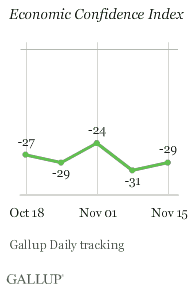
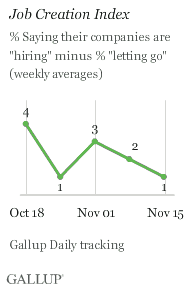
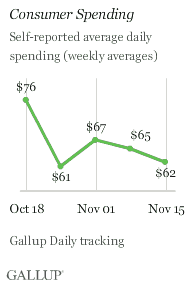
What Happened (Week Ending Nov. 15)
-
Consumer Spending was essentially unchanged, as self-reported average daily spending in stores, restaurants, gas stations, and online averaged $62 last week -- compared to $65 and $67 in the prior two weeks. Although spending declined in the comparable week last year, during a time of depressed spending as the financial crisis continued, spending last week was still down 23% from a year ago. Even though Economic Confidence is now much higher than it was at this time last year, consumer spending has remained flat during October-November, and continues to trail last year's comparables by 20% to 35% on a weekly basis.
-
Economic Confidence was also essentially unchanged last week, as Gallup's Economic Confidence Index was -29, compared to -31 the prior week. Both components of the Economic Confidence Index were stable last week. Consumer assessments of the current economy are not much different than during the previous week, with 48% rating the economy "poor" and 11% rating it "excellent" or "good." The same is true for the economic outlook over the next 12 months, with 58% saying the economy is "getting worse," compared to 59% the previous week and 56% a month ago. Thirty-seven percent of Americans describe the economy as "getting better" -- also not much different than the 36% of the prior week and the 38% of a month ago. With Wall Street continuing to surge, economic confidence remains near its four-month low, although still much better than a year ago.
-
Job Creation was also essentially unchanged last week, with Gallup's Job Creation Index at +1, compared to +2 the prior week. The percentage of employees saying their companies are hiring was 24% -- down one point from the prior week and two points from a month ago. The percentage saying their companies are letting people go remains at 23% -- about the same as it has been since the beginning of October. The jobs situation remains dismal as the rate of job losses has stabilized while hiring continues to languish. The jobs measure at this time last year was at +3, little different from today. Beginning at about Christmas last year, the Job Creation Index dipped into negative territory and stayed there for the first half of this year.
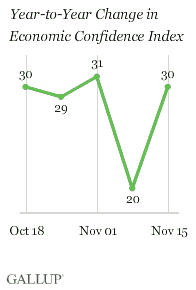
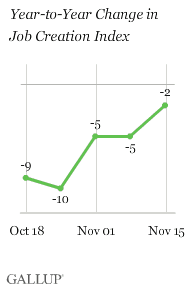

What to Watch For
The divergence between Wall Street and Main Street could become an increasingly difficult subject politically if current economic trends persist. While many economic forecasters seemed surprised when Reuters/University of Michigan reported that consumer sentiment fell last month, such a decline was consistent with . Now, economic confidence on Main Street continues to languish even as the stock market continues to soar. Although the dollar's plunging value seems to be a strong positive for Wall Street, it exhibits no such benefits in the average consumer's perceptions.
In this regard, . The recent government report of a double-digit unemployment rate and the increasing recognition that nearly one in five Americans is unemployed or underemployed may have helped increase the public's focus on jobs. At the same time, Gallup's Job Creation Index shows that the job situation facing most Americans on Main Street has not gotten better -- while the rate of layoffs seems to have stabilized, new job creation has not improved. Further, many employers are cutting the hours and the wages of their employees.
In turn, a lack of consumer optimism combined with a dismal job outlook cannot spell good things for consumer spending and retailers this holiday season. Gallup's Christmas spending surveys show , down from $740 in October. This is not as sharp a decline as was true between these two months last year -- a plunge inspired by the financial crisis -- but the resulting spending level is close to the intended spending average for November and December last year. This suggests Christmas spending this season may be as anemic as it was last year during the depths of the recession and the financial crisis.
The reality is that average daily spending overall, including Christmas gifts, needs to show an increase of 30% to 40% from its current level of around $65 just to match readings from Gallup's Consumer Spending measure of $90+ during last year's Christmas season -- a spending level higher than 优蜜传媒has found for any week so far in 2009. This may be possible if consumers have been holding back on their spending and plan to let go for the holidays. The huge sums investors are making on Wall Street could also help some high-end retailers. Still, consumers face tighter credit and a much higher unemployment rate this Christmas -- not to mention reduced inventories and the related possibility that this year's holiday sales may not be as good as last year's.
It would be helpful if a little of the unbridled optimism on Wall Street could spread to Main Street and the job market. That would be the best holiday gift not only for the nation's consumers and retailers but also for the American economy.

Review and export the complete daily trends on these measures: ; ; ; ;
about Gallup's economic measures.
Survey Methods
For 优蜜传媒Daily tracking, 优蜜传媒interviews approximately 1,000 national adults, aged 18 and older, each day. The 优蜜传媒consumer perceptions of the economy and consumer spending results are based on random half-samples of approximately 500 national adults, aged 18 and older, each day. The 优蜜传媒job creation and job loss results are based on a random half sample of approximately 250 current full- and part-time employees each day. Results from the week of Nov. 9-15, 2009, are based on telephone interviews with 3,458 adults for the consumer perceptions and spending questions. For these results, one can say with 95% confidence that the maximum margin of sampling error is 卤2 percentage points. Results for the job creation and job loss questions are based on interviews with 1,921 employees, with a maximum margin of error of 卤3 percentage points.
Interviews are conducted with respondents on land-line telephones and cellular phones.
In addition to sampling error, question wording and practical difficulties in conducting surveys can introduce error or bias into the findings of public opinion polls.
